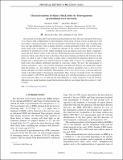| dc.contributor.author | Vitale, Salvatore | |
| dc.contributor.author | Whittle, Christopher Mark | |
| dc.date.accessioned | 2018-11-15T17:50:01Z | |
| dc.date.available | 2018-11-15T17:50:01Z | |
| dc.date.issued | 2018-07 | |
| dc.date.submitted | 2018-05 | |
| dc.identifier.issn | 2470-0010 | |
| dc.identifier.issn | 2470-0029 | |
| dc.identifier.uri | http://hdl.handle.net/1721.1/119125 | |
| dc.description.abstract | Gravitational waves detected by advanced ground-based detectors have allowed studying the Universe in a way which is fully complementary to electromagnetic observations. As more sources are detected, it will be possible to measure properties of the local population of black holes and neutron stars, including their mass and spin distributions. Once at design sensitivity, existing instruments will be able to detect heavy binary black holes at redshifts of ∼1. Significant upgrades in the current facilities could increase the sensitivity by another factor of few, further extending reach and signal-to-noise ratio. More is required to access the most remote corners of the Universe. Third-generation gravitational-wave detectors have been proposed, which could observe most of the binary black holes merging anywhere in the Universe. In this paper, we check if, and to which extent, it makes sense to keep previous-generation detectors up and running once a significantly more sensitive detector is online. First, we focus on a population of binary black holes with redshifts distributed uniformly in comoving volume. We show that measurement of extrinsic parameters, such as sky position, inclination and luminosity distance can significantly benefit from the presence of a less sensitive detector. Conversely, intrinsic parameters such as detector-frame masses and spins are largely unaffected. Measurement of the source-frame masses is instead improved, owing to the improvement of the distance measurement. Then, we focus on nearby events. We simulated sources similar to GW150914 and GW151226 and check how well their parameters can be measured by various networks. Here, too, we find that the main difference is a better estimation of the sky position, although even a single triangular-shaped third-generation detector can estimate their sky position to 1 deg² or better. | en_US |
| dc.description.sponsorship | National Science Foundation (U.S.) | en_US |
| dc.description.sponsorship | Laser Interferometer Gravitational Wave Observatory | en_US |
| dc.publisher | American Physical Society | en_US |
| dc.relation.isversionof | http://dx.doi.org/10.1103/PhysRevD.98.024029 | en_US |
| dc.rights | Article is made available in accordance with the publisher's policy and may be subject to US copyright law. Please refer to the publisher's site for terms of use. | en_US |
| dc.source | American Physical Society | en_US |
| dc.title | Characterization of binary black holes by heterogeneous gravitational-wave networks | en_US |
| dc.type | Article | en_US |
| dc.identifier.citation | Vitale, Salvatore, and Chris Whittle. “Characterization of Binary Black Holes by Heterogeneous Gravitational-Wave Networks.” Physical Review D, vol. 98, no. 2, July 2018. © 2018 American Physical Society | en_US |
| dc.contributor.department | Massachusetts Institute of Technology. Department of Physics | en_US |
| dc.contributor.department | MIT Kavli Institute for Astrophysics and Space Research | en_US |
| dc.contributor.department | LIGO (Observatory : Massachusetts Institute of Technology) | en_US |
| dc.contributor.mitauthor | Vitale, Salvatore | |
| dc.contributor.mitauthor | Whittle, Christopher Mark | |
| dc.relation.journal | Physical Review D | en_US |
| dc.eprint.version | Final published version | en_US |
| dc.type.uri | http://purl.org/eprint/type/JournalArticle | en_US |
| eprint.status | http://purl.org/eprint/status/PeerReviewed | en_US |
| dc.date.updated | 2018-07-16T18:00:19Z | |
| dc.language.rfc3066 | en | |
| dc.rights.holder | American Physical Society | |
| dspace.orderedauthors | Vitale, Salvatore; Whittle, Chris | en_US |
| dspace.embargo.terms | N | en_US |
| dc.identifier.orcid | https://orcid.org/0000-0003-2700-0767 | |
| mit.license | PUBLISHER_POLICY | en_US |
